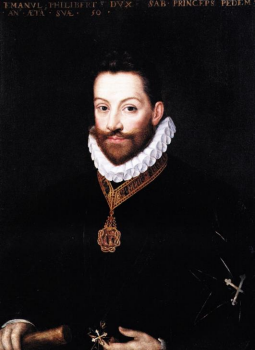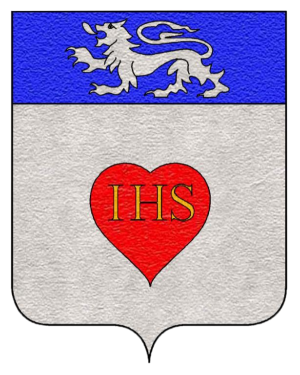Altessano, deriving from the Latin “Alte et Sanum” (“Tall and healthy”) was so named because it was placed in an elevated position and therefore of healthy nature. According to the Bocchini’s historical thesis, on its territory the castrum “Altessani” was already present in Roman times, on the road that led to the iron mines in the Lanzo valley, a small farmers’ and shepherds’ village, placed to control the raids of invaders and raiders, which found refuge in the woods nearby.
Divided and enfeoffed, during the Middle Ages, to more families and used as goods for exchange to cement the relationships between the court and the local nobility, after 1560 it was returned to the hands of the Savoy and on June 10th 1564 it was given again, for twenty-four thousand gold shields of the sun together with the title of Count, by Emanuele Filiberto to Nicolao Henry of Cremieu. The House of Cremieu, which became extinct for lack of male heirs, at first the Falletti from Druento took over and then the Barolo family.
After the Napoleonic parenthesis, during which Altessano became a fraction of the Borgaro community, the government of Carlo Alberto, based on criteria of simplification and rationalisation of state structures, gathered Altessano and Venaria Reale, not without opposition from the population of Venaria.
In the 20th century, the presence of a plant of the SNIA Viscosa caused migratory flows from Veneto and from the south of the country to satisfy the demand for labour, creating contrasts between the population of Altessano and the new one. Scourged since the outbreak of the two wars, it was overwhelmed by the sudden industrial development of the 70s which, by initiating a tumultuous process of growth, transformed regional planning,causing a break with the layout of the area in the XVIIth century: the rural landscape of the 1960s, characterized by a vast expanse of agricultural greenery, punctuated by the ancient farmsteads of the Opera Pia Barolo, was replaced, in less than a decade, by a stretch of concrete and residential complexes.
The Cremieus in Altessano
(The events of the Cremieu in the Duchy of Savoia narrated here, are derived from various bibliographical sources, sometimes not in agreement. It is therefore considered that the proposed text, although exhaustive, may report gaps that only further historical research can fill.)
The House of Cremieu has its roots in the Dauphiné.
Henry of Cremieu, with the Treaty of Cateau-Cambrésis (1559) moved to Piedmont, to the court of Emanuele Filiberto. French naturalized Nicolas (Nicolao) Henry de Cremieu1, together with his family, in 1576, by concession of the French king Henry III, continued the work of territorial expansion in the Savoia’s duchy, progressively abandoning all possessions beyond the Alps (Galli 2006, p. 116).
The gentleman, married Violante, the daughter of Filippo Count of Savoia – Racconigi, (Treccani Biographical Dictionary of Italians: part SAVOIA RACCONIGI, Filippo, count of), the eldest of six sisters, the last heir of the branch of Savoia-Racconigi, deriving from the Acaja, princes of Piedmont. In 1565 the duke Emanuele Filiberto gave to Count Nicolas Henry de Cremieu, his Squire, the fief of Altessano Inferiore, with the benefit of heredity. This meant that after the death without heirs of the Count, Altessano would return to the Savoia (Balma, Bertolone, Bracco, Caglio, Gallian, Rolando 1996. p. 19).
The acquisition of the fief of Altessano took place in several passages: Nicolas Henry de Cremieu, engaged with the acquisition of new lands in Piedmont, bought, at first, the fief of Stupinigi to give it, in 1564, to the duke Emanuele Filiberto, in exchange for Altessano Inferiore, fund originally owned by Pietro Cara, senator and ambassador of an ancient aristocratic family, and later by Renato Birago, general commissioner for supplies in Piedmont. (Galli 2006, p, 116).

The fief of Altessano Inferiore, divided and enfeoffed to several families, including the Arcour and the Scaravelli, was used as a bargaining chip to cement the relationship between the court and the local nobility, after 1560 it was returned to the hands of Savoia to be sold again, for twenty-four thousand gold shields of the sun, together with the title of Count, on June 10th 1564, from Emanuele Filiberto to Nicolas Henry de Cremieu, who would later inherit the entirety of the Altessano Inferiore fiefdom.
Nicolas Henry de Cremieu renovated and later inhabited the castle in Altessano Inferiore. He established the Parish, which he would later give to his own daughter as a dowry, financed its renovation and gained the right to appoint priests from Girolamo della Rovere, Archbishop of Turin. On November 14th 1577 the Archbishop would also grant him the right to split the Parish in two, Altessano Inferiore (now S. Lorenzo) and Altessano Superiore (now S. Maria Vergine). The separation would later be confirmed between 1584 and 1585 by pastor Angelo Peruzzi. That same year, Don Giovanni Boeti would become priest of the Altessano Inferiore parish. He would remain the priest for 23 years, before his death in 1608. (Balma, Bertolone, Bracco, Caglio, Gallian, Rolando 1996. p. 83)
Paola de Cremieu, Nicolas Henry’s daughter, married Carlo Provana in 1580. Because of this, and licenses from Carlo Emanuele I on September 22nd 1580, the Provana family acquired a large number of allods and fiefdoms, from the Madonna di Campagna area to the lands of Druent and Altessano, building a vast empire and racking up money and power. Carlo Provana would pass away in 1599.
With the death of Nicolas Henry de Cremieu, his son Ottavio, second Count of Altessano, would inherit the fiefdom. He was still a child, so his mother Violante would later assume control of his properties. Duke Carlo Emanuele I would gift him additional territories in Altessano Superiore, on the 10th of October 1602, because of the death of their owner with no heirs. Between 1603 and 1607 Ottavio was appointed Grand Squire. The rise to power of young Ottavio was rapid, he entered the court as a page, becoming a gentleman of the chamber in 1589 and first squire in 1593. As a sign of affection for him, Duke Carlo Emanuele I in his will of 1605 decided to leave him “all our stable, a piece of arms, a sword of ours and 500 shields of entrance for him and his children”. This esteem on the part of Carlo Emanuele I,however, did not prevent the great squire, involved in a court scandal, probably in 1607, from being removed from Turin and “deprived of office with misfortune of His Highness.” (Stango, Merlin, 1998, p. 263).
Evidently the punishment of Ottavio was temporary because on April 14th,1608, we find him in the fullness of his functions. In fact, he indicated Don Giovanni Cristoforo di Strambino (Ivrea), as parish priest of Altessano Inferiore by the Archbishop of Turin Carlo Broglia.Don Giovanni Cristoforo Settimo will give up his office on 30th June 1631 after 23 years of parochial care. (Balma, Bertolone, Bracco, Caglio, Gallian, Rolando 1996. p. 83).
The Lord of Altessano Inferiore, Ottavio Henry de Cremieu,was responsible for the discovery of the relics of San Marchese, patron saint of the village of Altessano.In fact, the discovery occurred on 26th June 1604 inside a late Roman chapel, in the presence of Cardinal Archbishop Carlo Broglia, the Duke of Savoy Carlo Emanuele I, Lord Ottavio Henry de Cremieu, Count of Altessano, under the high altar a wooden box came to light, now worn, containing the relics of the saint. (Balma, Bertolone, Bracco, Caglio, Gallian, Rolando 1996. p. 19 e 20).
On 22nd November 1621, new lords entered the fief of Altessano Superiore, in particular Ottavio Henry de Cremieu, lord of the nearby Altessano Inferiore; the extinction of the male line of the Cremieu let the Provana of Druenttake over, the highest and most qualified Piedmontese nobility: Paola de Cremieu, daughter of the last descendant Nicolao, married Carlo Provana, whose eldest son, Francesco, was later invested with the fief of Altessano Superiore. (De Franco 2014.Feud. (AST,Joined Sections, Camerale Piemonte, Index of feuds, vol. 283, AB in AZ, Altessano Superiore, 1621, november 22nd)).
This marriage concludes the epic of the Cremieu. Other families would follow each other on the stage of the history of Altessano.
1Nicolas Henry de Cremieu, Guyot Henry’s don, count of Cremieu (? – 1545), lord of Quirieu, of Balme nel Delfinato and of Pernette Faure. (cfr. Cremieu family tree, in https://gw.geneanet.org/pierfit?lang=fr&p=nicolas&n=henry&oc=11).

Bibliography
Ballone, Racca 1998: BALLONE Adriano, RACCA Guglielmo, “All’ombra dei Savoia. Storia di Venaria Reale”, Allemandi Editor, Turin, 1998.
Balma, Bertolone, Bracco, Caglio, Gallian, Rolando 1996: BALMA Anacleto, BERTOLONE Felice, BRACCO Sergio, CAGLIO Paolo, GALLIAN Gianni, ROLANDO Paolo. Altessano and the Pia Società of San Marchese. 1996.
Caglio 2012: CAGLIO Paolo, Parish Church of the Nativity of the Virgin Mary- Venaria Reale(Turin). 1762/2012. 250° of Consecration. Commercial Typography, 2012.
Castagno 2002: CASTAGNO Paolo, “Notizie sulla famiglia Provana”, Carignano Stultifera Navis, 2002.
Watch also https://docplayer.it/5639135-paolo-castagno-notizie-sulla-famiglia-provana.html
De Franco 2014: DE FRANCO Davide, Venaria Reale, study published on https://www.archiviocasalis.it/localized-install/biblio/torino/venaria-realeSitografia5
Fricchione, Perrotta 2018: FRICCHIONE Erica, PERROTTA Elia, “Specificità e identità costruite intorno a una Reggia: la città di Venaria Reale (XVII – XXI secolo)”, Master degree thesis on Planning of the City and the Territory, Rapporteur Lucia Carle, 2018.
Published on: http://lnx.pubblitesi.it/schede-sintetiche/area-scientifica/1367-elia-perrotta-specificita-e-identita-costruite-intorno-a-una-reggia-la-citta-di-venaria-reale-xvii-xxi-secolo
Galli 2006: GALLI Elena. “Tra Dora e Stura: Il territorio di Altessano tra seicento e ottocento
dall’Archivio Barolo”. Architecture degree thesis , Academic year 2005-2006. Rapporters: Vera Comoli and Vittorio Defabiani.
Miranti 2006: Don MIRANTI Michelangelo. 1906-2006 “Cent’anni della chiesa di San Lorenzo Martire in Altessano – Venaria Reale”. Commercial typography, Venaria Reale, 2006
Stango, Merlin 1998: Stango C., Merlin P., “La corte da Emanuele Filiberto a Carlo Emanuele I, in Storia di Torino, Vol. III” edited by G. Recuperati, Giulio Einaudi Ed., Turin, 1998.
Treccani Dizionario Biografico degli Italiani – Volume 91, 2018.
Web references: Chronology of the parish of San Lorenzo
https://digilander.libero.it/slorenzovenaria/date.htm



